Ramaraj, a wholesale tomato trader from Kanpur, Uttar Pradesh, has been camping in Kolar in south Karnataka, which has now turned into a bustling centre for tomato procurement for the entire country after the crop failed in Maharashtra and elsewhere. But he is yet to make significant purchases, given the unprecedented price of the produce in the Kolar market. A 15 kg box of tomatoes was sold at ₹2,200 on July 11 at the yard, which traders believe is the highest ever since the market’s inception.
At the Kolar yard, buyers come from across the country. They have been camping here for over a month now, procuring tomatoes for states as far as West Bengal, Uttar Pradesh, Madhya Pradesh, Rajasthan, and Gujarat, apart from neighbouring states like Andhra Pradesh and Tamil Nadu.
Explained | Why are tomato prices still high?
Largest supply
Karnataka, particularly Kolar, whose market is the second largest tomato trading centre in Asia, has the largest supply of tomatoes in the country now. However, it is sparse compared to previous years. The situation has turned so precarious that the Union government and some states like Tamil Nadu have had to procure tomatoes in the open market, mainly from Kolar, and sell them at subsidised rates.
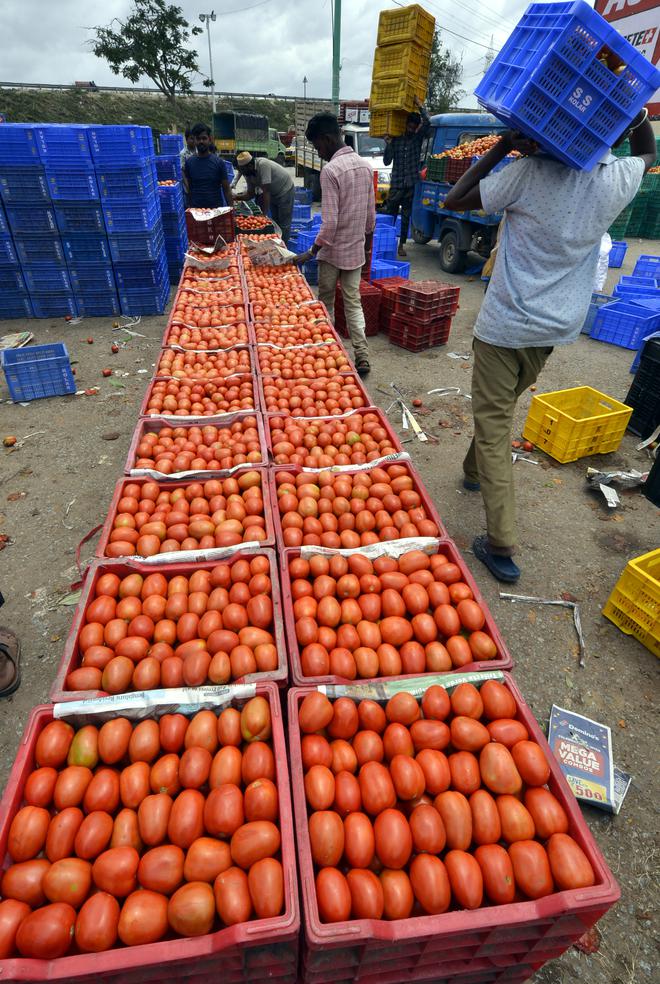
“A 15 kg box of tomatoes has been trading at over ₹2,000 for over a week. Sending them across to Kanpur, bearing the additional cost of nearly ₹13 per kilo, only leads to losses. Due to high prices, demand for tomatoes has fallen back home. I have adopted a wait-and-watch approach to see if prices stabilise,” Ramaraj said.
But Rashid Bhai from the nearby Jhansi and Manoj Mishra from Jabalpur, Madhya Pradesh, have been sending a few loads of tomatoes home. “The price of tomatoes back home has touched ₹200 per kilo in the retail market, and the demand has fallen. This season has become unviable,” Rashid said.
This comes amidst not only rising prices but also allegations of traders hoarding tomatoes, artificially jacking up prices for buyers, even as they purchase at lower prices from farmers. The cost of tomatoes has shot up to such unprecedented levels that multiple “tomato heists” have been reported, restaurants have cut down on the use of tomatoes, and people have taken to using alternatives like tamarind, mango, and lemon for sourness in cooking at homes in Karnataka.
Dwindled supply in Kolar too
However, in Kolar, too, the crop is ravaged by leaf curl disease, and the yield is only 30-40% of the usual. Compared to previous years when the market was jam-packed during this time of the year, the arrivals at the market are sparse. This has driven prices to unprecedented levels.
Data from the Kolar Agricultural Produce Market Committee (APMC) shows a drastic decline in the arrivals of tomatoes this season compared to the same period in previous years.
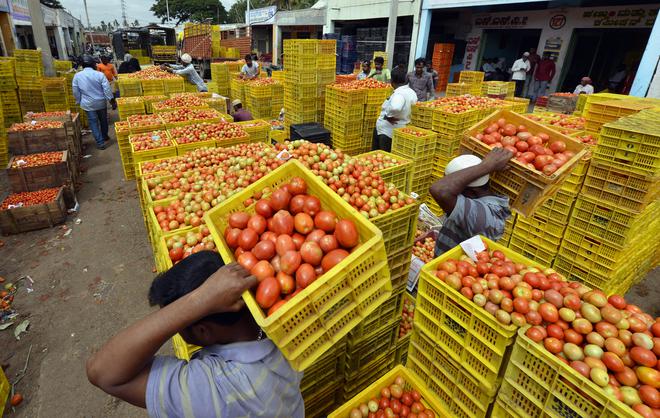
While 3.3 lakh quintals of tomatoes were traded at Kolar APMC in June 2023, it was 5.45 lakh quintals in June 2022, 9.3 lakh quintals in June 2021 and 6.9 lakh quintals in June 2020, indicating an over 50% drop this season.
However, the data also shows the price of tomatoes to be the highest ever since 2019. While the average minimum cost of a quintal of tomatoes was around ₹300 and the average maximum price was around ₹3,000 during the 2019-2022 period, the average minimum price is ₹2,000 and the average maximum price ₹13,330 in July 2023.
“This season, volumes traded at our APMC seem to be the lowest in recent memory. We are the country’s largest market for tomatoes from June to August. But given the scarce supply this year, traders from Bangladesh, Afghanistan, and Pakistan who used to make a beeline at the market every year haven’t turned up, even as buyers from across the country have been camping here for over a month now. Though the prices have increased to unprecedented levels, farmers are reeling under losses as the volumes are very low. Only a few big farmers seem to have made some money, which seems to have unfortunately dominated the news,” said N. Vijayalakshmi, Secretary, Kolar APMC.
Farmers continue to make losses
Farmers who had come to sell their produce at the market on Wednesday were upset despite a high price of ₹1,900 per box at the auction. K.C. Ramappa from Kallikuppa village, who has grown tomatoes on his meagre 1-acre farm, said despite high prices, he had suffered losses for the fourth consecutive year.
“The entire crop in the farm is infected by leaf curl disease, which has drastically reduced the yield. I used to get at least 20 harvests of 250-300, 15 kg boxes totalling around 5,000-6,000 boxes per crop. The price has been meagre for the past four years, and we incurred losses. But this year, the price may have on average fetched nearly ₹1,200 per box,” he said, adding that his yield had dropped to around 30 boxes per harvest and only 6-8 harvests this crop due to the stunted growth of the infected crop.
“This is even as the input costs have shot up severely due to the cost of pesticides. Even as I have spent over ₹3 lakh to grow this crop, I am still far away from earning it back,” he explained.
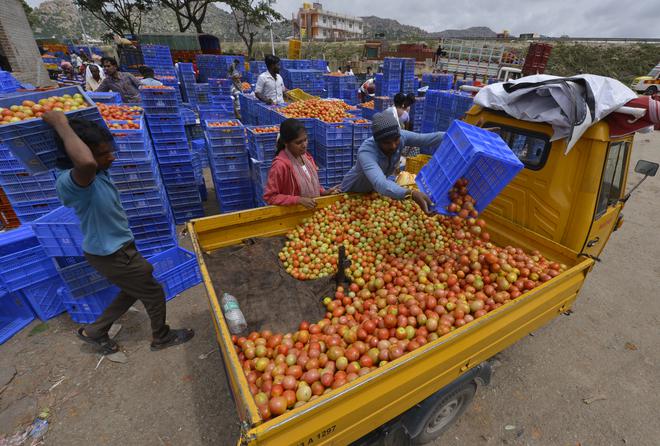
The story of most farmers who had come to sell their produce at the Kolar APMC Yard was no different. Suresh Kumar, another farmer from Chinnappanahalli village from the district, commenting on the precariousness of the tomato crop, said it was often “Sikkidre Shikari, Ildidre Bhikari” (You either hit a bounty or become a pauper) and added despite the prices being very high this year, the only solace to the farmers was a reduction in the quantum of losses compared to the previous years.
At the 2.5-acre farm of Raghavendra Raju, a progressive tomato farmer in Mangasandra near Kolar town, the entire crop was infected with leaf curl disease. Plants that usually grow to a height of 5-6 feet have a stunted growth at around 2.5 feet, leading to their yield being severely cut short. “Though the prices are high, we are unable even to recover our investment, which has gone up several times due to the cost of spraying pesticides,” he lamented. When The Hindu visited his farm, a representative of a pesticide company had come calling to prescribe “solutions” to the farm and was at the receiving end of farmers’ ire, as the farmers alleged the pesticides were “ineffective” in controlling the disease.
Leaf curl disease ravages crop
S.R. Kumaraswamy, Deputy Director, Horticulture, Kolar district, said that most of the summer crop of tomatoes had been ravaged by leaf curl disease, leading to low yields. Leaf curl is a viral tomato crop disease transmitted through the white fly vector prevalent in the district’s fields this summer.
“In March-April months, when the present crop was sown, the temperature was high, and there were some showers in April, which created a friendly environment for the virus to thrive and spread. Given there is no cure for viral diseases, almost the entire crop has been ravaged,” he said, adding the yield of the summer crop was as low as 30-40% of the expected result.
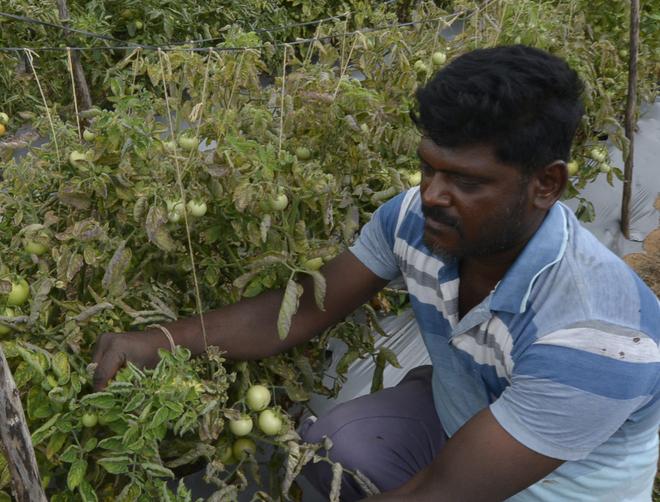
Denying farmers’ charges that the department had done little to help them control the disease, he said they had been carrying out campaigns advising farmers on ways to avoid spreading the virus.
“We have advised farmers to plant maise or any such border crop at the fields to ensure the viral load is reduced by the time it reaches the tomatoes. But very few farmers have done this. Most of them have also not put up yellow sticky traps as instructed in the fields. We have also been organising workshops for nurseries to ensure the saplings there are not infected,” he said.
But farmers said the Department officials were busy with elections, and by the time they woke up, the crop had already been irretrievably infected. They also alleged widespread corruption and that the government officials often sided with seed and pesticide companies and did not hold them to account for crop failure.
Looking ahead
It is hoped that the skyrocketing prices of tomatoes will come down with the harvest of the next crop, expected to start by August 15 in Maharashtra and Madhya Pradesh. However, the prognosis for the next crop in Kolar does not seem good, indicating there may not be much relief soon, especially given the impact of El Nino and the resultant monsoon deficit this season.
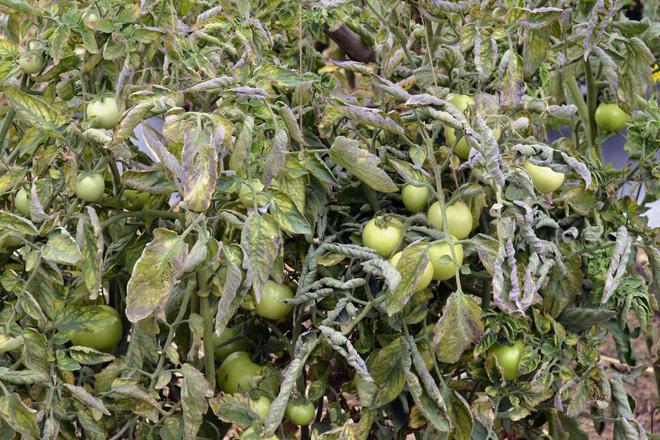
Sowing for the Kharif crop during the rainy season is underway in Kolar, and the harvest of this crop is expected to start by August end. However, at least two farms The Hindu visited showed the new crop also developing the leaf curl disease.
“There is a high chance that the Kharif crop will also be infected with the disease as it already exists in the fields. We hope there are good rains now so that there is a drop in temperature and the white fly population is washed away. If not, the disease may also become widespread in the upcoming crop,” said Kumaraswamy.
Govt and Opposition indifference
Narayana Gowda, an outspoken farmer, said they were contemplating modes of protest to attract the government’s attention to their plight.
“We want to pluck all disease-infected plants and dump them in the State capital to demand justice. Neither the government nor the Opposition has been speaking about us, even as media narratives are dominated by stories of a handful of big farmers who do mechanised farming on a large scale making profits,” he said, demanding a regulatory framework for seed and pesticide companies where they are held accountable by the performance of the crop.
“The government should formulate an effective response to the disease immediately to save the upcoming crop,” he said.







